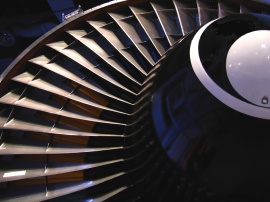

RPMTurbo - Flutter Maps
The main features of RPMTurbo flutter maps are:
- Plots aerodynamic damping over a wide range of operating conditions
- Quasi-3D Navier-Stokes flow simulation with full turbulence modeling
- Full resolution of flutter boundary
- Can be used to determine the flutter margin
- Produced in two weeks from receiving blade geometry
RPMTurbo can calculate flutter maps for:
| Compressors | Turbines |
|---|---|
 |
 |
Fluttermaps can also be calculated for Fans.
Flutter maps are contour plots of the aerodynamic damping as a function of operating condition for a given mode shape and frequency. Over 200 operating points are plotted on each flutter map. The aerodynamic dampings for all possible aeroelastic modes (traveling wave modes) are calculated at each operating point, and the minimum value is plotted. Over 10,000 unsteady flow simulations are required to construct each flutter map. RPMTurbo has developed highly efficient and advanced flow solvers that can produce these flutter maps in two weeks from receiving the blade geometry.
RPMTurbo flutter maps clearly show the flutter boundary due to the large number of operating points on the map. Flutter maps can be used by design engineers to determine the flutter margin (flutter margin is the difference between the operating envelope and the flutter boundary).
RPMTurbo flutter maps are plotted over a wide range of operating conditions. Flow separation occurs at the high positive and high negative flow incidences and at the higher inlet Mach numbers. For these conditions, it is necessary to consider viscous and turbulent effects. RPMTurbo performs steady and unsteady (linearized) simulations based on the Reynold's averaged Navier-Stokes equations with the Spalart and Allmaras turbulence model to produce these flutter maps.